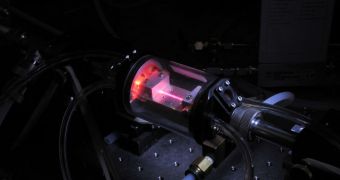Engineers from the US National Science Foundation's (NSF) Engineering Research Center (ERC) for EUV Science and Technology announce the development of a laser-like, coherent and directed light beam that contains photon wavelengths ranging from ultraviolet to X-rays.
This is one of only a handful of sources that can produce a coherent light beam that includes X-rays. However, it is the only machine of this class that fits on a tabletop. The device is the result of a collaboration between scientists from several countries.
The beam is obtained by focusing a series of extremely brief, infrared light pulses into a high-pressure gas cell. The complex quantum interactions that occur within give rise to a coherent super-continuum of light, whose composing wavelengths reach all the way to the X-ray portion of the spectrum.
Interestingly, the X-ray burst has a shorter wavelength than the original IR laser pulse that spawned it. What this implies is that experts will soon be able to use it to make previously impossible observations, such as the flow of charges and spins in materials, or the motions of electrons during reactions.
The technique the team used to produce this super-continuum of light is called high-harmonic generation (HHG), and it was first discovered back in the late 1980s. “This is the broadest spectral, coherent-light source ever generated,” Henry Kapteyn explains.
The expert holds an appointment as an engineering and physics professor at the University of Colorado in Boulder (UCB) JILA, an organization formerly known as the Joint Institute for Laboratory Astrophysics. Spanish and Austrian researchers were also part of the team.
“It definitely opens up the possibility to probe the shortest space and time scales relevant to any process in our natural world other than nuclear or fundamental particle interactions,” the expert goes on to say.
“Just as a violin or guitar string will emit harmonics of its fundamental sound tone when plucked strongly, an atom can also emit harmonics of light when plucked violently by a laser pulse,” adds scientist Margaret Murnane, a JILA expert that was the co-principal investigator on the study.
“The laser pulse first plucks electrons from the atoms, before driving them back again where they can collide with the atoms from which they came. Any excess energy is emitted as high-energy ultraviolet photons,” she concludes.

 14 DAY TRIAL //
14 DAY TRIAL //